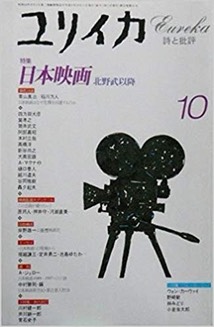
I’ve been uploading some of my old articles to the Yale repository, but most have been the ones in English. This time I decided to upload a rather unique piece I did in 1997.
As some of you know, I picked the best ten Japanese films of the year for the annual Eiga geijutsu poll for a number of years. But my first experience in producing a “best” list for publication was a few years before that in 1997, when the Japanese intellectual journal Yuriika (Eureka) asked me to produce a list for a special issue devoted to the theme "Japanese Cinema: From Kitano Takeshi On." I was asked to write an article selecting the thirty best Japanese films made since Kitano Takeshi debuted as a director in 1989. The time span and the number of films was the editor’s choice, but the project intrigued me as an assertion not only that a period of cinema began in 1989, but also that the period was significantly defined by Kitano. I of course cited that in my book on him.
I was also intrigued by the possibility of selecting what is “the best.” Yes, there was a tiny bit of excitement over participating in the process of canon formation (though frankly I don’t think anyone has ever cited this list as a canon former), but I was more enthusiastic about being able to support some excellent films, including a few virtually unknown works. More importantly, this was an opportunity for a precocious young scholar to interrogate the concept of the “best” list itself. In the end, I selected films that themselves questioned the categories assumed by the list itself, particularly the notions of “Japan” and “cinema.”
They were films that, at least to me at the time, were imbricated in trends problematizing the nation and media. I decided not to rank them, but instead group them under one of five rubrics which exemplified this questioning of identity and cinema: "The Appearance of Others," "The Encounter with Death," "Wandering Identities," "Alternative Identity," and "New Japanese Entertainment Film.” As a matter of policy, I did not select two or more films by the same director.
The eventual list included quite a number of films that are now “canonical,” from Tetsuo to Sonatine, but I’m proud to say I included some, like Cure, even before they were released in Japan. I was also proud to include some experimental works, such as Sekine Hiroyuki’s Ruins of Roppongi, that are masterpieces, but are virtually never shown (since Sekine shot that work on 8mm). I also included some films, such as Swallowtail Butterfly, that I do not like (you can read my critique of it here), but which I nonetheless thought significant. Some, like Ame no wadachi, were never really shown again, but I feel including such films is another way of questioning canon formation. And of course, there are a few I would probably not pick if asked to choose today. This list is thus also a historical relic.
Here is the bibliographic information for the article, which you can download from the Yale Repository:
- アーロン・ジェロー「日本映画1989-1997ベスト30 <日本>と<映画>を再定義するための一仮説」 『ユリイカ』 第29巻第13号(1997年10月)
- Aaron Gerow, "Nihon eiga 1989-1997 besuto 30: 'Nihon' to 'eiga' o saiteigi suru tame no hitokasetsu" (The Best 30 Japanese Films 1989-1997: A Proposal for Redefining “Japan” and “Film”). Yuriika (Eureka) 29.13 (October 1997): 292-298.
The article is in Japanese, so for those of you who can’t read Japanese, here at least is the titles of my “best 30” films:
BEST 30 JAPANESE FILMS: 1989-1997
The Appearance of Others
- Untamagiru (ウンタマギルー, Takamine Go, 1989)
- Swimming with Tears (Afureru atsui namida/あふれる熱い涙, Tashiro Hirotaka, 1991)
- All Under the Moon (Tsuki wa dotchi ni dete iru/月はどっちに出ている, Sai Yoichi, 1993)
- Swallowtail Butterfly (Suwaroteiru/スワロウテイル, Iwai Shunji, 1996)
- Junk Food (Janku fudo/ジャンク・フード, Yamamoto Masashi, 1997)
The Encounter with Death
- Ruins of Roppongi (Roppongi no haikyo/六本木の廃墟, Sekine Hiroyuki, 1992)
- Sonatine (Sonachine/ソナチネ, Kitano Takeshi, 1993)
- Ame no wadachi (雨の轍, Ito Nobuyuki, 1993)
- Elephant Song (Erefanto songu/エレファント・ソング, Riju Go, 1994)
- Like a Rolling Stone (Bo no kanashimi/棒の哀しみ, Kumashiro Tatsumi, 1994)
- Another Lonely Hitman (Shin kanashiki hittoman/新・悲しきヒットマン, 1995)
Wandering Identities
- Tetsuo (鉄男, Tsukamoto Shin’ya, 1989)
- Moon Over the Desert (Showa guntoden 2: Tsuki no sabaku/昭和群盗伝2 月の砂漠, Zeze Takahisa, 1990)
- Pat Labor 2: The Movie (Kido keisatsu patoreiba 2: the Movie/機動警察パトレイバー2, Oshii Mamoru, 1993)
- August in the Water (Mizu no naka no hachigatsu/水の中の八月, Ishii Sogo, 1995)
- Helpless (Aoyama Shinji, 1996)
- Cure (Kurosawa Kiyoshi, 1997)
Alternative Identity
- Swimming Prohibited (Yuei kinshi/遊泳禁止, Oki Hiroyuki, 1989)
- Embracing (Ni tsutsumarete/につつまれて, Kawate Naomi, 1992)
- Moving (Ohikkoshi/お引越し, Somai Shinji, 1993)
- Like Grains of Sand (Nagisa no Shindobaddo/渚のシンドバッド, Hashiguchi Ryosuke, 1995)
- Gonin (Ishii Takashi, 1995)
New Japanese Entertainment Film
- Dotsuitarunen (どついたるねん, Sakamoto Junji, 1989)
- Bataashi kingyo (バタアシ金魚, Matsuoka Joji, 1990)
- Nowhere Man (Muno no hito/無能の人, Takenaka Naoto, 1991)
- Sumo Do Sumo Don’t (Shiko funjatta/シコふんじゃった, Suo Masayuki, 1992)
- Tokiwa: The Manga Apartment (Tokiwaso no seishun/トキワ荘の青春, Ichikawa Jun, 1996)
- Dangan Runner (Dangan ranna/弾丸ランナー, Sabu, 1996)
- My Secret Cache (Himitsu no hanazono/秘密の花園, Yaguchi Shinobu, 1997)
- Princess Mononoke (Mononoke hime/もののけ姫, Miyazaki Hayao, 1997)

